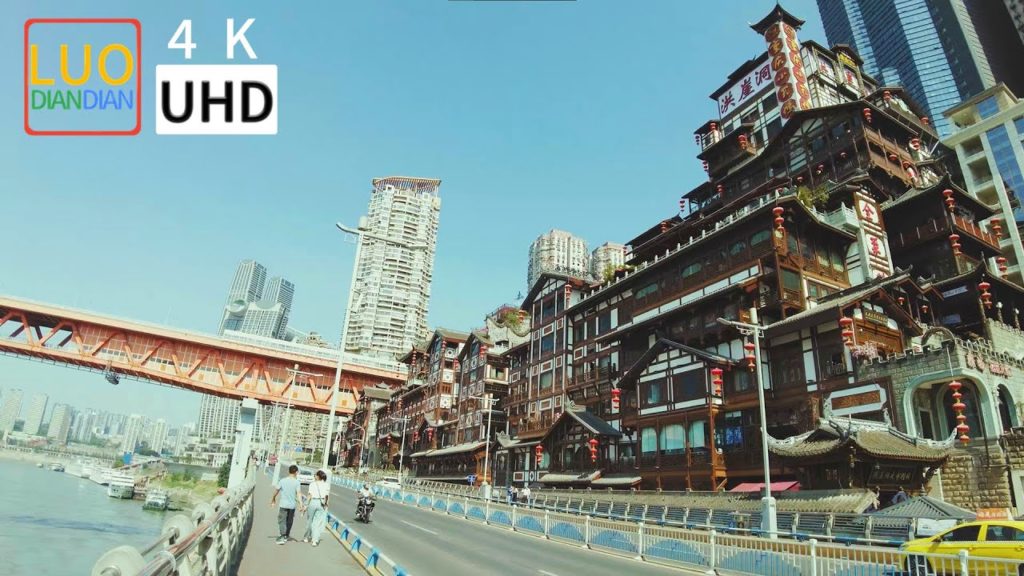Chaotianmen Square is a newly-built architecture which situates at the confluence of the Yangtze and Jialing Rivers in the Peninsula of Yuzhong District in Chongqing. This square has gradually become a prosperous zone which shows the rapid development of this historic city.
Standing on the Chaotianmen Square, visitors can get an ideal view to the glorious Yangtze River. The Chaotianmen Square was built in the summer of 1998, covering an area of 800,000 square meters, and the ship-shaped square is one of the largest roof squares in China. This gorgeous river which mixes the past and the present culture of Chongqing City just flow in front of your eyes. During the festival period, there is a large-size ship model which is consisted of thousands of flowers in the center of this Chaotianmen Square for visitors to take photos.
It is composed by four major parts namely the View Scenery Square, the protection shore ladder road, the traffic square and the peripheral environment. It is a symbolic construction of integrated water collection and key position land transportation function. Four towers stand at the corners of a generous public podium planted with Banyan trees. The composition of four buildings represents a four pillared gateway, as well as the four winds, the four seasons, and the four directions of the world. The towers are each 40 metres by 40 metres in plan and stand 80 metres from each other. The total developed area below podium level is 370,000 squares metres with a further 400,000 square metres above podium level.
Chaotianmen Square
History
It is said that Chaotianmen was built in 314 BC, when constructed Ba prefecture after country Ba was perished by Qin general Zhangyi
In the early Ming dynasty, Daiding expanded the old city of Chongqing and built 17 gates according to the number of 8 tri-grams and 9 halls diagram, one of the largest gate is the Chaotianmen. Upon the gate there was four characters originally: 古渝雄关 which means Ancient Chongqing Impregnable Pass. Because this gate stands in the same direction of Yangtze River flowing east, facing imperial city Nanjing, so the gate used to welcome the royal, so it named “Chao Tian Men (Have an Audience with Emperor Gate)”.
Chongqing became commercial port in 1891, there was established customhouse in Chaotianmen. In 1927, because of building Chaotianmen wharf, the old gate was removed. In 1949 “9 · 2″fire disaster made 2 km area around Chaotianmen wharf run into ruins, from then on, Chaotianmen only remained city walls.
Today’s Chaotianmen passenger terminal, the newly built magnificent Chaotianmen square, is a good place for overlooking the convergence of two rivers and appreciating the scenery along the river.
Chaotianmen Square
Highlights
On the left side of Chaotianmen, small streams collected in Jialing River, longitudinal flow is 1119 km, and go into the Yangtze River here. Whenever the early summer or Mid-Autumn, the flow impact of green Jialing River and the Yellow Yangtze River makes whirlpool, pure and turbid, very spectacular. On the right side of the Yangtze River is Rongjialing River, passing through the Three Gorges, flowing down vigorously, become a “gold water part” of the Yangtze River.
Chongqing Highway “zero kilometers” sign is located in Chaotianmen Square. “Zero kilometers” is the starting point of a country or a city main road, is also a symbol of the city center. China’s “zero kilometers” sign position has been confirmed in the middle of the Tiananmen Square, and “Zero kilometers” of Shanghai is in the People’s Square.
What to see in Chaotianmen
【Chaotianmen Wharf】
Chongqing is the birthplace of the Yangtze River Three Gorges, therefore Chongqing has the Yangtze River Three Gorges tourism resource, every year Chongqing receives millions of tourists. In order to meet the huge demand of the Three Gorges tourism market, Chaotianmen several big docks is swamped with all kinds of sole proprietorship, joint venture tonner Yangtze River cruise.
【Fugui Stone】
Lady Tushan stood in rock projecting over water, awaited for her husband to come back, therefore it named “Fugui Stone (Husband Come Back Stone), also known as “Hugui Stone (Calling Back Stone)”.Chaotianmen occupied the golden waterway hub, one of the main traffic hub for Chongqing. After 1949, the terminal was undergoing extension repeatedly, expanded along the two rivers. Passenger terminal building rose from ground, and passenger and cargo cable car straight in the both sides of river.
*This introduction comes from topchinatravel*


AloJapan.com